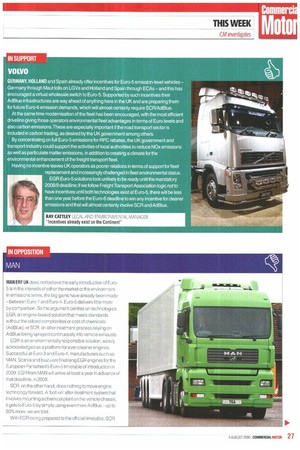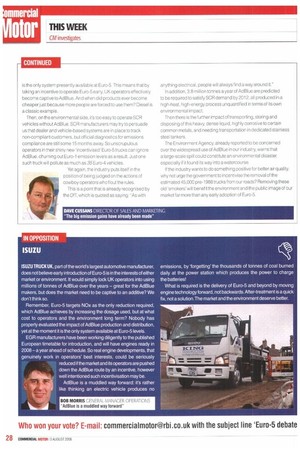MAN
Page 27

Page 28

If you've noticed an error in this article please click here to report it so we can fix it.
MAN ER F UK does notbelieve the early introduction of Euro5 is in the interests of either the market or the environment. In emissions terms, the big gains have already been made -between Euro-1 and Euro-4. Euro-5 delivers little more by comparison. So the argument centres on technologies: EGA, an engine-based solution that meets standards without the added complexities or cost of chemicals (AdBlue); or SCR, an after-treatment process relying on AdBlue being sprayed continuously into vehicle exhausts.
EGR is an environmentally responsible solution, widely acknowledged as a platform for ever-cleaner engines. Successful at Euro-3 and Euro-4, manufacturers such as MAN, Scania and lsuzu are finalising EGR engines for the European Parliaments Euro-5 timetable of introduction in 2009. EGR from MAN will arrive at least a year in advance of that deadline. in 2008.
SCR, on the other hand, does nothing to move engine technology forward. A 'bolt-on' after-treatment system that involves mounting a chemical plant on the vehicle chassis, it gets to Euro-5 by simply using even more AdBlue up to 50% more we are told.
With EGR being prepared to the official timetable, SCR is the only system presently available at Euro-5. This means that by taking an incentive to operate Euro-5 early, UK operators effectively become captive to AdBlue. And when did products ever become cheaper just because more people are forced to use them? Diesel is a classic example.
Then on the environmental side, it's too easy to operate SCR vehicles without AdBlue. SCR manufacturers may try to persuade us that dealer and vehicle-based systems are in place to track non-compliant customers, but official diagnostics for emissions compliance are still some 15 months away. So unscrupulous operators in their shiny new `lncentivlsed Eura-5 trucks can ignore AdBlue, churning out Euro-1 emission levels as a result. Just one such truck will pollute as much as 35 Euro-4 vehicles.
Yet again, the industry puts itself In the position of being judged on the actions of cowboy operators who flout the rules.
This Is a point that is already recognised by the DfT, which is quoted as saying: "As with anything electrical, people will always find a way around it."
In addition, 3.8 million tonnes a year of AdBlue are predicted to be required to satisfy SCR demand by 2012, all produced in a high-heat, high-energy process unquantified in terms of its own environmental impact.
Then there is the further impact of transporting, storing and disposing of this heavy, dense liquid, highly corrosive to certain common metals, and needing transportation in dedicated stainless steel tankers.
The Environment Agency, already reported to be concerned over the widespread use of AdBlue in our industry, warns that a large-scale spill could constitute an environmental disaster, especially if it found its way into a watercourse, If the industry wants to do something positive for better air quality, why not urge the government to incentivise the removal of the estimated 45,000 pre-1988 trucks from our roads? Removing these old 'smokers' will benefit the environment and the pubic image of our market far more than any early adoption of Euro-5.




























































































































































































